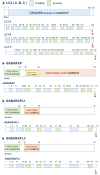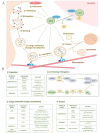Role of the mammalian ATG8/LC3 family in autophagy: differential and compensatory roles in the spatiotemporal regulation of autophagy
- PMID: 27418283
- PMCID: PMC5070729
- DOI: 10.5483/bmbrep.2016.49.8.081
Role of the mammalian ATG8/LC3 family in autophagy: differential and compensatory roles in the spatiotemporal regulation of autophagy
Abstract
Autophagy, an evolutionarily conserved cellular degradation pathway of the lysosome, is associated with many physiological and pathological processes. The hallmark of autophagy is the formation of the autophagosome that engulfs and degrades cytosolic components via its fusion with the lysosome, in either a selective or a non-selective manner. Autophagy is tightly regulated by proteins encoded by autophagy-related (atg) genes. Among these proteins, ATG8/ LC3 is essential for autophagosome biogenesis/maturation and it also functions as an adaptor protein for selective autophagy. In mammalian cells, several homologs of yeast Atg8 such as MAP1LC3, GABARAP, and GABARAPL 1/2 have been identified. However, the biological relevance of this gene diversity in higher eukaryotes, and their specific roles, are largely unknown. In this review, we describe the mammalian ATG8/LC3 family and discuss recent advancements in understanding their roles in the autophagic process. [BMB Reports 2016; 49(8): 424-430].
Figures


References
Publication types
MeSH terms
Substances
LinkOut - more resources
Full Text Sources
Other Literature Sources
Molecular Biology Databases

